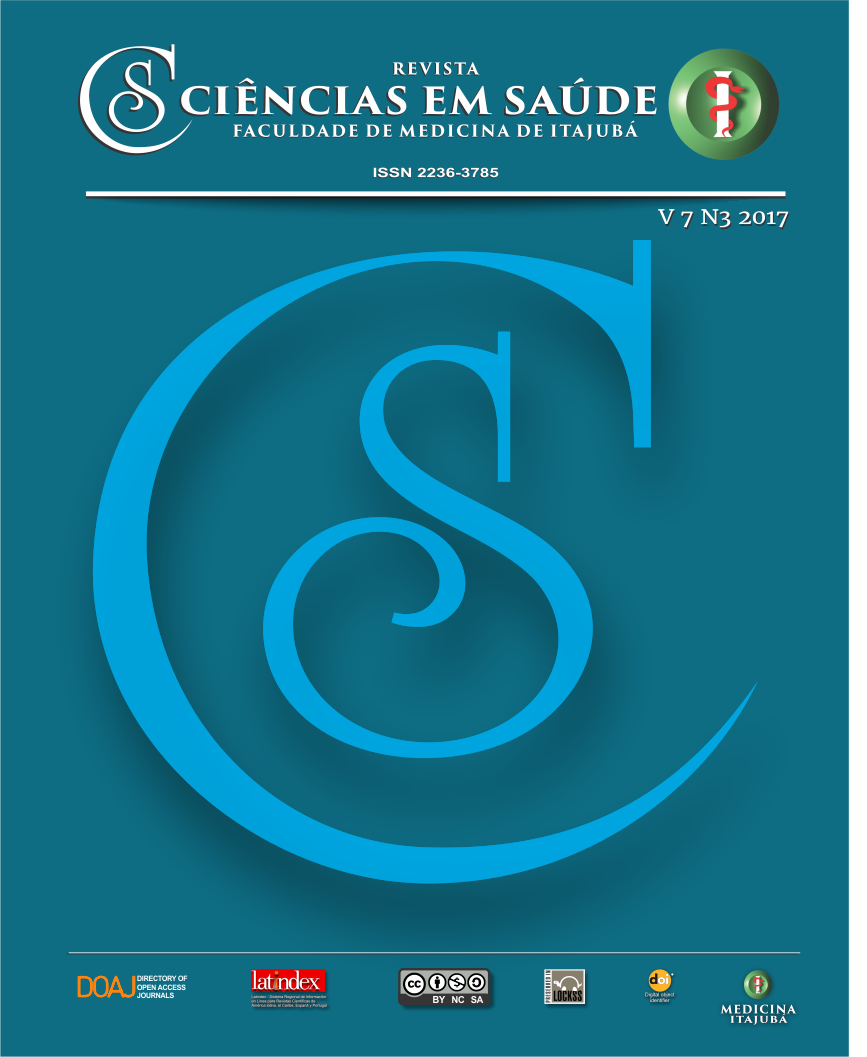Análise dos fatores de risco relacionados ao tromboembolismo venoso em mulheres de idade fértil em Itajubá – Minas Gerais / Analysis of risk factors related to venous thromboembolism in women of childbearing age in Itajubá – Minas Gerais
Main Article Content
Abstract
Introdução: O tromboembolismo venoso (TEV) incide em mulheres de idade fértil e a identificação dos fatores de risco é ponto crucial para sua prevenção. Objetivos: Identificar e correlacionar os fatores de risco mais comuns para o desencadeamento de TEV em mulheres de 14 a 50 anos. Métodos: Analisadas 30 mulheres com diagnóstico recente de trombose venosa profunda (TVP) de membros inferiores por meio de ultrassonografia com Doppler colorido e de seus prontuários, no período de julho de 2011 a julho de 2016. Os fatores de risco foram descritos em proporções e comparados através de teste exato de Fisher. Resultados: A média de idade foi de 37,4 anos. O índice de massa corpórea médio foi de 27,4 kg/m2 e a média de gestações foi de 2,3 por paciente. Setenta por cento apresentaram TVP, e a prevalência em ambos os membros foi igual. Cirurgias recentes, história familiar de TEV, doenças associadas e uso de contraceptivos orais (CO) foram os mais prevalentes na população estudada (53,8%, 42,3%, 42,3% e 38,5%, respectivamente). Uso de CO, cirurgia recente e varizes de grosso calibre foram os fatores mais relacionados à recorrência da trombose (p<0,05). Conclusão: Pode-se concluir que a presença de varizes, cirurgia recente e história familiar são os fatores de risco mais associados à presença de TVP em mulheres de idade fértil. Uso de CO, cirurgia recente e presença de varizes são os fatores de risco mais estatisticamente relacionados à recorrência da TVP.
Palavras-Chave: Tromboembolia venosa; Saúde da mulher; Fatores de risco
ABSTRACT
Introduction: Venous thromboembolism (VTE) affects women of childbearing age and the identification of risk factors is a key point for preventing its development. Aims: To identify and correlate the most common risk factors for the development of VTE in women aged 14-50 years. Meth-ods: We analyzed 30 women with recent diagnosis of deep venous thrombosis (DVT) of the lower limbs using Doppler color ultrasonography and their medical records from July 2011 to July 2016. Risk factors were described as proportions and compared using Fisher’s exact test. Re-sults: The mean age was 37.4 years. The mean body mass index was 27.4 kg/m2 and the mean gestation rate was 2.3 per pa-tient. Seventy percent presented DVT, and the prevalence in both limbs was the same. Recent surgeries, familiar historical of VTE, associated diseases and use of oral contraceptives (OC) were the most preva-lent factors in the studied population (53.8%, 42.3%, 42.3% and 38.5%, respec-tively). Use of OC, recent surgery and varicose veins were the factors most related to recurrence of thrombosis (p<0.05). Conclusion: It can be concluded that the presence of varicose veins, recent surgery and family history are the risk factors that are most associated with the presence of DVT in women of childbearing age. Use of OC, recent surgery and presence of varicose veins are the risk factors more statistically related to recurrence of DVT.
Keywords: Venous thromboembolism; Women’s health; Risk factors
Article Details
Authors maintain copyright and grant the HSJ the right to first publication. From 2024, the publications wiil be licensed under Attribution 4.0 International 
 , allowing their sharing, recognizing the authorship and initial publication in this journal.
, allowing their sharing, recognizing the authorship and initial publication in this journal.
Authors are authorized to assume additional contracts separately for the non-exclusive distribution of the version of the work published in this journal (e.g., publishing in an institutional repository or as a book chapter), with acknowledgment of authorship and initial publication in this journal.
Authors are encouraged to publish and distribute their work online (e.g., in institutional repositories or on their personal page) at any point after the editorial process.
Also, the AUTHOR is informed and consents that the HSJ can incorporate his article into existing or future scientific databases and indexers, under the conditions defined by the latter at all times, which will involve, at least, the possibility that the holders of these databases can perform the following actions on the article.
